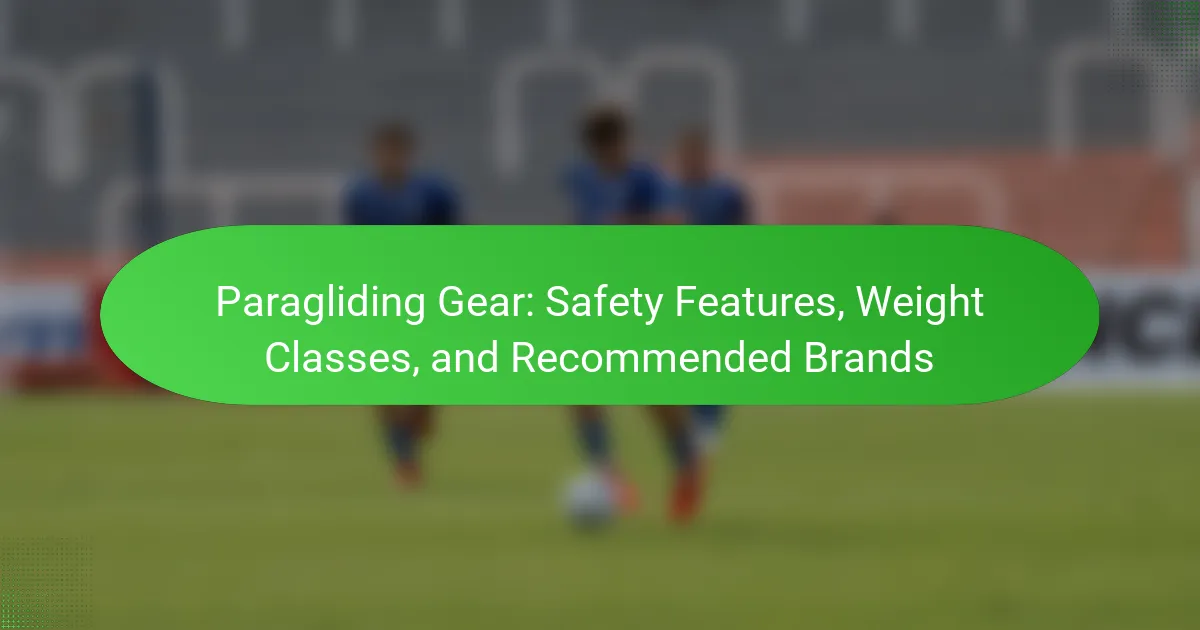Choosing the right paragliding gear is crucial for safety and performance. This article explores essential safety features, the impact of weight classes on flight efficiency, and top recommended brands. Understanding these aspects will help you make informed decisions for a safer and more enjoyable paragliding experience.

What are the essential safety features of paragliding gear?
The essential safety features of paragliding gear include reserve parachutes, harnesses with back protection, and durable wing materials. Reserve parachutes provide an emergency backup for safe landings. Harnesses with back protection minimize injury risks during a fall. Durable wing materials enhance overall reliability and performance in various weather conditions.
How do harness designs enhance safety during flights?
Harness designs significantly enhance safety during flights by providing stability and support. They distribute weight evenly across the body, reducing the risk of injury during turbulence. Features like quick-release buckles ensure rapid evacuation in emergencies. Additionally, harnesses with integrated back protection minimize the impact during landings. The use of high-quality materials increases durability and reliability, which are crucial for safe paragliding experiences.
What role do reserve parachutes play in emergency situations?
Reserve parachutes play a critical role in emergency situations by providing an additional safety measure for paragliders. They are designed to deploy quickly if the main parachute fails, ensuring a safer descent. The reliability of reserve parachutes is vital, as they can significantly reduce the risk of injury or fatality during unexpected malfunctions. Regular maintenance and checks enhance their effectiveness, making them an essential component of paragliding gear.
Which materials are most effective in creating durable and safe wings?
Nylon and polyester are the most effective materials for creating durable and safe wings. These fabrics offer high strength-to-weight ratios and excellent resistance to UV damage. Nylon is lightweight and provides good elasticity, while polyester is more resistant to stretching and shrinking. Reinforcements with ripstop patterns enhance durability. Additionally, advanced coatings improve water resistance and aerodynamics.

How does the weight class of paragliding gear impact performance?
The weight class of paragliding gear significantly impacts performance by influencing maneuverability, stability, and overall flight efficiency. Lighter gear enhances agility, allowing pilots to respond quickly to changing conditions. Conversely, heavier gear may provide better stability in turbulent air but can hinder performance. Optimal weight classes vary based on pilot skill and flight conditions, making it essential to choose gear that aligns with individual needs and preferences. For example, a lightweight wing might be ideal for cross-country flights, while a heavier wing could excel in dynamic soaring situations.
What are the different weight classes for paragliding gear?
Paragliding gear is categorized into weight classes to ensure safety and performance. The main weight classes are lightweight (up to 85 kg), mid-weight (85 kg to 100 kg), and heavy-weight (over 100 kg). Each class is designed to optimize flight characteristics and safety for pilots within those weight ranges.
How do weight classes affect flight characteristics and handling?
Weight classes significantly influence flight characteristics and handling in paragliding. Lighter pilots benefit from enhanced maneuverability and responsiveness, while heavier pilots experience increased stability and glide performance.
The weight range for a paraglider is crucial; being within the recommended limits ensures optimal performance. For example, a pilot exceeding the weight limit may find the glider less responsive, while a lighter pilot may struggle with lift.
Additionally, the wing’s design and aspect ratio interact with weight. High aspect ratio wings, suitable for lighter pilots, offer better performance in thermals but may be harder to control. Conversely, lower aspect ratio wings provide stability for heavier pilots but may sacrifice some efficiency.
Understanding these dynamics helps pilots choose appropriate gear, enhancing safety and enjoyment while paragliding.
Which weight class is best for beginners versus experienced pilots?
Beginners should choose lighter paragliding gear, typically under 80 kg, while experienced pilots can opt for heavier gear above 80 kg. Lighter gear offers better maneuverability and safety for novices. Experienced pilots benefit from stability and performance with heavier gear.

What are the most recommended brands for paragliding gear?
The most recommended brands for paragliding gear include Ozone, Nova, Advance, and Gin. These brands are recognized for their safety features, lightweight designs, and performance. Ozone offers a range of wings suitable for different weight classes, while Nova is known for its innovative technology. Advance provides high-quality gear with reliable safety ratings, and Gin is favoured for its unique designs and performance in various conditions.
Which brands are known for their safety innovations?
Brands known for their safety innovations in paragliding gear include Ozone, Advance, and Nova. These brands prioritise advanced materials and design features that enhance safety. Ozone is recognized for its cutting-edge wing stability and deployment systems. Advance focuses on robust construction and reliable reserve parachute integration. Nova emphasizes user-friendly designs that improve pilot control and safety during flight.
What factors should be considered when choosing a brand?
When choosing a paragliding gear brand, prioritise safety features, weight classes, and user reviews. Consider the durability of materials and the brand’s reputation for reliability. Look for certifications that ensure compliance with safety standards. Evaluate the availability of customer support and warranty options. Assess the range of gear suitable for different skill levels and conditions.
How do regional preferences influence brand popularity in paragliding?
Regional preferences significantly shape brand popularity in paragliding by influencing consumer choices based on safety features and weight classes. In regions with diverse weather conditions, brands that offer gear tailored for specific climates gain traction. For instance, lightweight gear is preferred in mountainous areas, while robust safety features are prioritized in regions with unpredictable weather. Local endorsements and cultural factors also play a role, as brands that resonate with regional values often see higher popularity. Additionally, the availability of recommended brands can vary, impacting consumer trust and loyalty.

What unique attributes should be considered when selecting paragliding gear?
When selecting paragliding gear, consider unique attributes like specific safety features, weight class compatibility, and brand reliability. Safety features include reserve parachutes and harness protection. Weight classes determine suitable gear for individual pilots. Recommended brands often emphasize durability and performance.
How does customization of gear improve pilot experience?
Customization of gear significantly enhances pilot experience by improving comfort, control, and safety. Tailored equipment allows pilots to adjust fit and performance to their specific needs, leading to better handling and increased confidence in the air. For instance, selecting the right weight class ensures optimal performance and stability during flight. Additionally, personalized safety features, such as harness adjustments, can enhance protection. Recommended brands often offer a range of customizable options, allowing pilots to select gear that aligns with their unique flying style and preferences.
What are the rare features that some paragliding gear offers?
Some paragliding gear offers rare features like integrated GPS tracking, advanced weather sensors, and customizable wing designs. These innovations enhance safety and performance for experienced pilots. Other unique attributes may include lightweight materials that improve portability and durability under extreme conditions.

What are the best practices for maintaining paragliding gear?
Regularly inspecting and properly storing paragliding gear ensures safety and longevity. Start by checking for wear and tear on fabric, lines, and harness. Clean your gear after each use to remove dirt and debris. Store in a cool, dry place away from direct sunlight. Follow manufacturer guidelines for maintenance and consider professional servicing annually. This routine enhances safety features and maintains performance across various weight classes.
How often should gear be inspected for safety?
Paragliding gear should be inspected for safety before every flight, with thorough checks conducted at least every six months. Regular inspections ensure that critical components like harnesses, lines, and canopies maintain their integrity and performance. Additionally, after any significant incident or exposure to harsh conditions, immediate inspection is essential. Proper maintenance enhances safety and extends the lifespan of the equipment.
What are common mistakes to avoid when caring for paragliding equipment?
Common mistakes to avoid when caring for paragliding equipment include neglecting regular inspections, using improper storage, and failing to clean gear after use. Regular checks ensure safety features function correctly, while proper storage prevents damage. Cleaning gear helps maintain its integrity and performance.
What expert tips can enhance the longevity of paragliding gear?
To enhance the longevity of paragliding gear, follow these expert tips: regularly inspect for wear, store in a cool, dry place, avoid UV exposure, and clean after each use. Proper maintenance extends the lifespan of safety features and materials. Ensure to use recommended brands known for durability and reliability.
